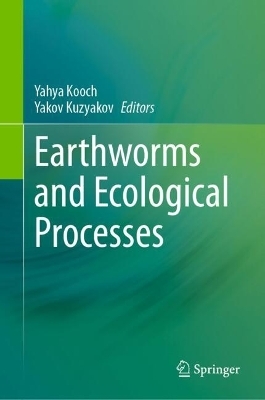
Earthworms and Ecological Processes
Springer International Publishing (Verlag)
978-3-031-64509-9 (ISBN)
- Noch nicht erschienen - erscheint am 10.12.2024
- Versandkostenfrei innerhalb Deutschlands
- Auch auf Rechnung
- Verfügbarkeit in der Filiale vor Ort prüfen
- Artikel merken
Earthworms are the most important members of the soil detritivore community and function as soil engineers because of their effects on soil properties and their influence on the availability of resources for other organisms, including microorganisms and plants. Soil productivity and plant growth are strongly affected by biological activities of earthworms. They act on soil structures through creation of burrows which facilitate water and gas transport, incorporation of litter into soil, mixing of soil minerals, organic materials and breaking down of soil organic matter, ejection of surface and or subsurface casts. Earthworms have positive effects on the soil fabric and on the decomposition and mineralization of litter by breaking down organic matter and producing large amounts of feaces, thereby mixing litter with the mineral soil. Therefore, they play an important part humus form changes according to the patterns of plant communities succession. Consequently, they are also good bio-indicators for soil and site quality, and are thus useful when planning ecosystem function improvements. Earthworm's populations are indicators in degraded regions and in soil reclamations. Aristole called them "intestines of the earth" and the eminent nineteenth century biologist, Charles Darwin, spent many years observing their major influence on humus formation and soil transport . However, the links between their impacts on the soil environment and the resulting modification of natural selection pressures on engineers as well as on other organisms have received little attention. Based on papers recently published in the Science journal, Phillips et al. (2019) document an impressive group effort by 141 researchers from 35 countries to develop a global-scale atlas of earthworms. In addition, Fierer (2019) described the earthworms' place on earth. So, Darwin's legacy continues. Despite the vast increase in scientific literature on earthworms in recent years, much remains to be known of their basic biology, ecology and functioning. In this book we summarized the current knowledge in relation to ecological processes involved with earthworms in croplands, rangelands, forests and urban soils.
Dr. Yahya Kooch is currently an Associate Professor of soil ecology at Tarbiat Modares University (TMU), Tehran, Iran.
His scientific activities concern soil ecology as well as biogeochemical cycles of carbon and nutients in ecosystems. His main research interests are i) pedodiversity in different land uses/covers, ii) linking soil biota communities with nutrient cycling processes, iii) Influence of soil properties and plant species on N availability, iv) evolution of organic matter in soils and sediments in relation to climate changes (sinks or sources of C?), and v) diversity of humus forms in terrestrial ecosystems.
Prof. Dr. Yakov Kuzyakov is currently a Professor of soil sciences at Georg-August-University of Göttingen, Germany.
His main research interests are in the fields of soil biogeochemistry, C and N turnover in the rhizosphere and other hotspots including drilosphere, and application of isotopes in ecosystem sciences. His expertise is soil ecology, biogeochemistry, rhizosphere ecology, soil degradation, C and N cycles, C sequestration, priming effects, nutrient mobilization, rhizodeposition, pedogenic carbonates, partitioning of CO2 fluxes, land use, low molecular weight organic substances, agroecology. stable and radioactive isotopes 'applications: labeling, natural abundance, isotope dilution, imaging.
Part I: Global distribution of earthworms and ecological processes.- Invasive earthworms and agricultural ecosystem processes in America.- Earthworms in Canadian forest regions revisited.- Earthworm ecology in Northern European forests.- Earthworms, ecological processes and climate change.- Part II: Earthworm communities in managed ecosystems.- Earthworms: functional traits and soil properties.- Earthworms and humus forms.- Earthworms and soil nutrients in agricultural ecosystems.- City dwellers: Earthworms in urban ecosystems.- The role of earthworms in grasslands.- Earthworm contributions to agricultural sustainability.- Part III: Earthworms, ecosystem services and future perspectives.- The role of earthworms in soil formation.- Earthworms and soil biogeochemical processes.- Earthworm effects on microbial and enzyme activities in soil.- Earthworms for soil organic matter mineralization and carbon sequestration.- Role of earthworms on C and N biogeochemical cycles and potential links to greenhouse gas emissions.- Earthworm biopores for transport and nutrient cycling.- Earthworm role in soil food webs.- Earthworms as soil ecosystem engineers.- Advances in earthworms as biological remediators of polluted soils.- Perspectives on the study of earthworms: the global impact of earthworms on soil health and plant ecology.- Part IV: Conclusion.- Historical perspectives on the study of earthworms: global issue.
| Erscheinungsdatum | 20.11.2024 |
|---|---|
| Zusatzinfo | VI, 556 p. 133 illus., 102 illus. in color. |
| Verlagsort | Cham |
| Sprache | englisch |
| Maße | 155 x 235 mm |
| Themenwelt | Naturwissenschaften ► Biologie ► Ökologie / Naturschutz |
| Schlagworte | Agriculture • bioremediation • climate change • Earthworm activity hotspots • Ecosystem health and function • Ecosystem services • Landscape dynamics and processes • Litter decomposition • Soil Biology • Soil Pollution • soil science |
| ISBN-10 | 3-031-64509-X / 303164509X |
| ISBN-13 | 978-3-031-64509-9 / 9783031645099 |
| Zustand | Neuware |
| Haben Sie eine Frage zum Produkt? |
aus dem Bereich


